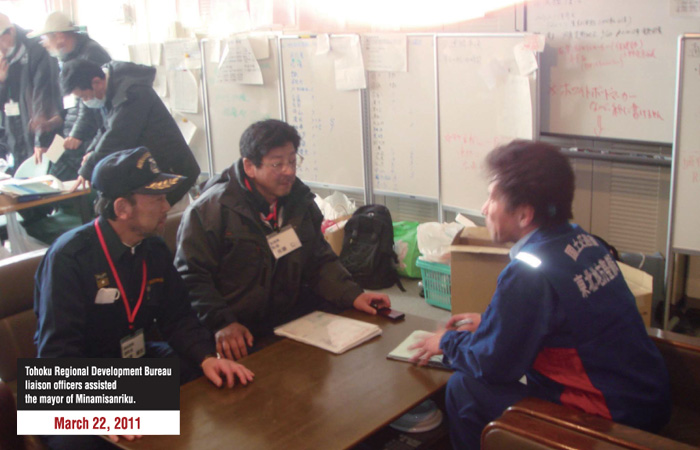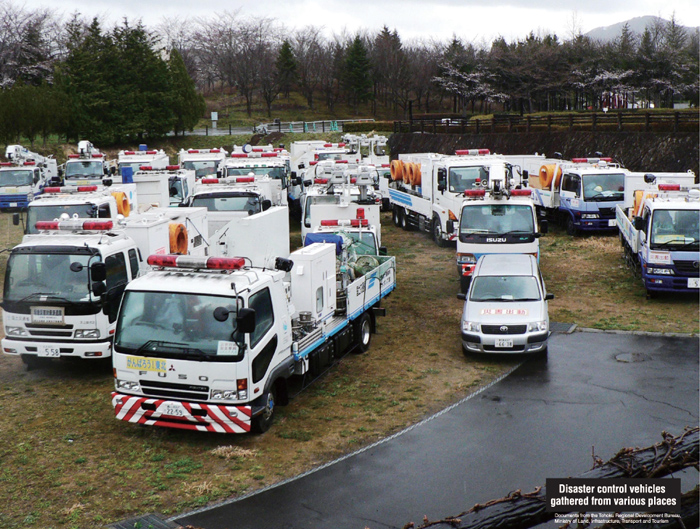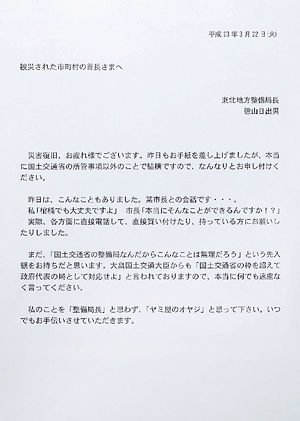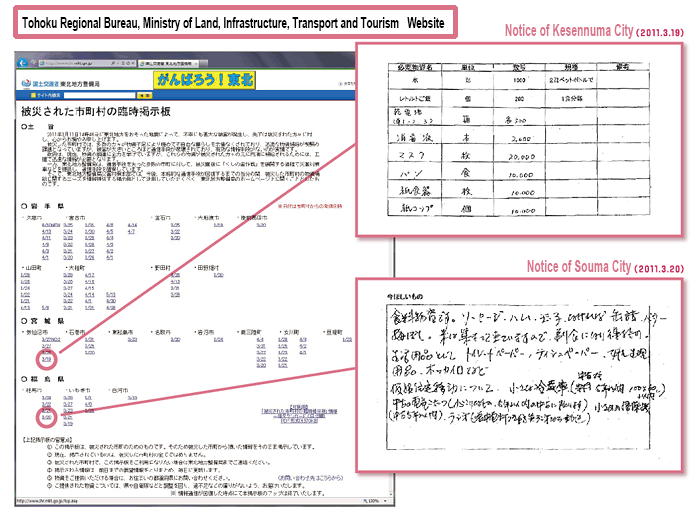Liaisons (on-site information coordinators for disaster response) were dispatched to the affected areas on the day of the disaster. They were required to understand the needs of the municipal leaders in details. They had been engaged in procurement and coordination activities of any kind of materials, as important and trusted partners of the municipal leaders.
“I will leave everything to your discretion. Saving people’s lives is the highest priority. Consider you a representative of the nation, and do whatever it takes.” Entrusted by the
Minister of Land, Infrastructure, Transport and Tourism, the liaisons procured everything ranging from a temporary housing substitute for city office, fuels, etc. to sanitary items and coffins for the affected areas. The mission was well beyond their routine work.
→For further details, see those who want to know more.
3. Support to the Disaster-Affected Areas
Relief supplies were sent to 31 municipalities in four prefectures.
The dispatched liaisons support prefectural and municipal functions.

The MLIT staffs were dispatched to the affected prefectures or municipalities, and worked as coordinators in the prefectural or municipal office.
They were called liaisons (on-site information coordinator for disaster response). Liaisons coordinated with various support organizations, according to the needs of the municipalities they understood. Liaisons are good at coordination between the prefectural and state organizations, and familiar with the relevant laws. They sometimes worked as local staffs on behalf of the municipal staffs who were completely occupied with disaster responses, and at other times as important and trusted partners of the municipal leaders. The liaisons were sent to 31 municipalities in 4 prefectures. The number of liaisons sent was 96 on March 23 at its peak. Total number of liaisons reached 3,916 by June 30, counted after the occurrence of the disaster.

Providing communication equipment to the affected municipalities.
Satellite communication vehicles substituted for completely cut communication systems of the affected municipalities.
The communication system, a lifeline for the disaster-affected people, had been completely disrupted. Some municipalities, having had damage to their municipal office, such as Minamisanriku in Miyagi Prefecture, even lost their administrative function.
From the second day following the disaster, the MLIT began mobilizing the disaster response vehicles called in from the Regional Bureaus all over Japan, and sent them to 16 municipalities by the fourth day. 192 disaster response vehicles were mobilized on April 15 at the peak. The vehicles secured the communication system connecting with all the affected municipalities, allowing their voices to be heard: for instance, about the magnitude of damage in details, what kind of relief supplies they really needed, etc. This eventually led to increasing support to the disaster-affected people.

Dealer of black market
Procurement went beyond the jurisdiction of the MLIT
A letter from the Tohoku Regional Bureau chief was handed over to the leaders of the affected municipalities by dispatched liaisons (on-site coordinator for disaster response). “Consider me a dealer of black market, and tell us anything you need”, said the letter. Although the “willingness to extend any kind of support even beyond the jurisdiction of the MLIT” was expressed in the previous message, most of the municipal leaders were hesitant about asking what was offered. That was why the message was so phrased, in an expression rarely used in official letters, to let the municipality leaders know that the message was indeed what it meant.
After this message, many municipality leaders indeed started contacting the Bureau for a variety of requests. The exceptional procurement began. Things ranging from temporary housing, portable toilets, fuels, etc. to sanitary items and coffins were procured.
A letter handed over to the municipal leaders

Tuesday, March 22, 2012
To the leaders of the affected municipalities
Hideo Tokuyama, chief of the Tohoku Regional Bureau
I guess you have been busy with restoration works. Though I said in my letter to you yesterday, I would repeat. Tell us anything you need, even if it is beyond the jurisdiction of the MLIT
Here is what happened yesterday. This is a conversation with a mayor.
I said, “We can deliver even coffins“.
“Really? That’s amazing, if you can do that”, said a mayor.
We actually called various people, and purchased coffins directly or made arrangement with coffin owners.
I guess you still think, “It must be impossible, because they are a member of the Regional Bureau under the MLIT”, but this is misconception. We have been told by Ohata, the Minister of Land, Infrastructure, Transport and Tourism, “Work as a representative of the Japanese Government, regardless of the jurisdiction of the MLIT”. So, tell us anything you need. Take the word as it is.
Consider me a “dealer of black market”, not a “Bureau chief”. We are willing to extend our help anytime.
Example of relief supplies As of March 31
| Item | Total amount | Number demanded | Number supplied |
|---|---|---|---|
| Temporary buildings | 300 | 12 | 8 |
| Carpet | 1,951㎡ | 2 | 0 |
| Insulating material | 6,990㎡ | 2 | 0 |
| Portable toilets | 1,039 | 11 | 11 |
| Tents | 576 | 7 | 4 |
| Coffins | 100 | 1 | 1 |
| Storage bags | 883 | 2 | 2 |
| Gasoline | 11,000L | 4 | 4 |
| Gas oil | 36,740L | 17 | 17 |
| Kerosene | 56,400L | 8 | 8 |
| Engine generators | 95 | 9 | 9 |
| Communication facility | 1 | 1 | 1 |
| Installation of satellite phone | 1 set | 1 | 1 |
| Backhoes | 6台 | 2 | 2 |
| Bottled water/tea | 31,900 | 8 | 8 |
| Daily necessities, food etc. | 1式 | 22 | 22 |
| Sanitary napkins | 300 | 1 | 1 |
| Diapers (for child/adult) | 500 | 1 | 1 |
| Futons | 300 sets | 1 | 1 |
| Washing machines | 30 | 2 | 2 |
| ・ ・ ・ |
|||
| Total | 218 | 198 | |
Response to requests after 3/13 (As of March 31)
- Request fulfillment rate 91%(=198/218)
- Average response time 2.93 days

Transmit to the whole country via affected municipality SOS website.
The space of the Bureau’s website was made available for the affected municipalities which lost a means of communication.
Disaster-stricken municipalities lost a means of effective communication. They must be having a hard time due to shortage of necessary goods - the MLIT Tohoku Regional Bureau made a “Temporary Bulletin Board for the Affected Municipalities“ on the Bureau’s website, until a full-scale communication means was restored in the municipalities. The bulletin was used by 20 municipalities as a space to make necessary announcements, for example, about their needs for relief supplies, etc. Urgent needs announced on this bulletin brought about the flow of relief supplies from all over Japan.

